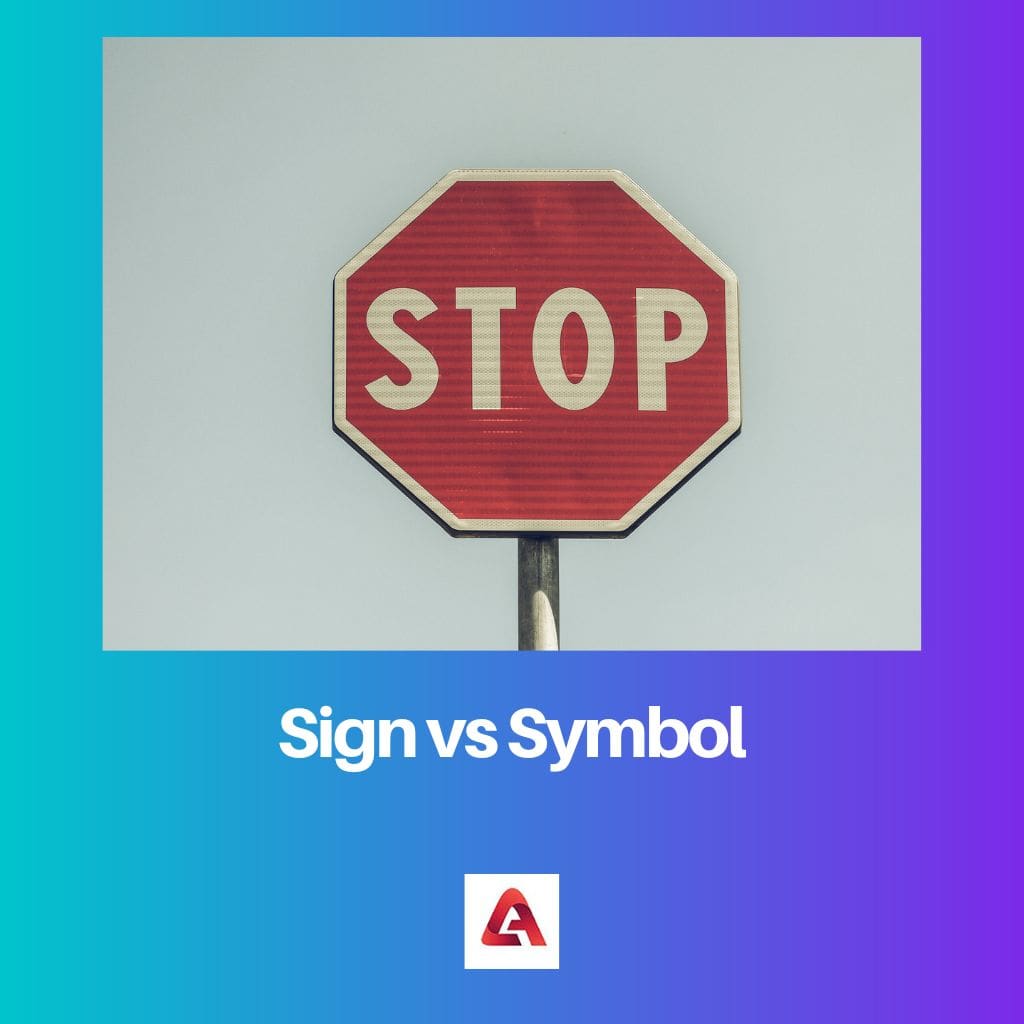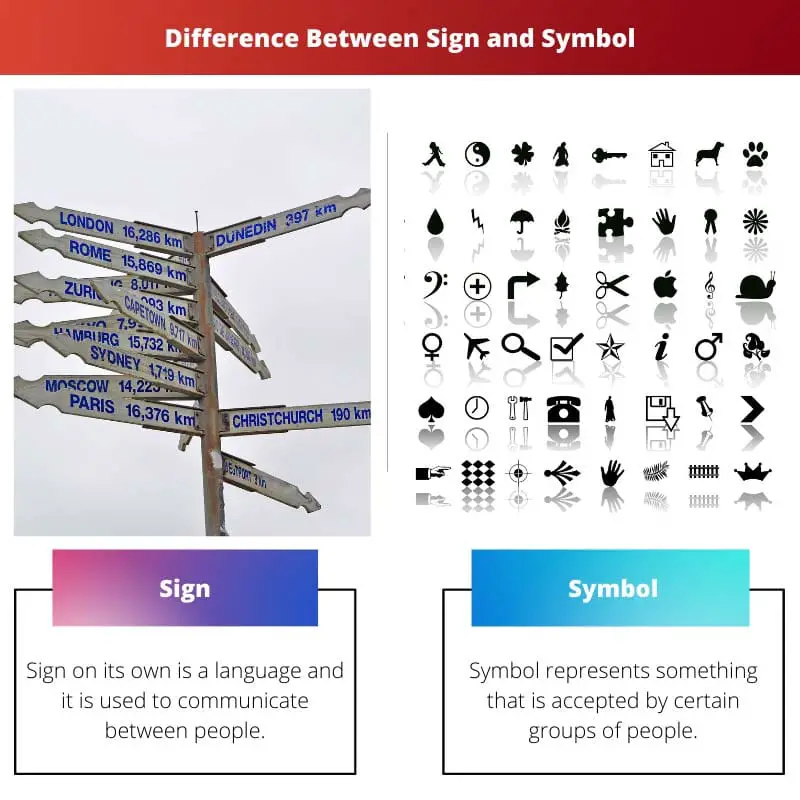Signs and symbols are graphical presentations. A sign is used to warn people or make them aware in some situations.
A symbol is something that a specific group of people accepts.
Key Takeaways
- A sign is a visual or auditory representation that directly conveys meaning, such as a stop sign or a sound indicating an event or action, having a literal connection to its meaning.
- A symbol represents an idea, concept, or object, indirectly and with a more abstract connection to its meaning, such as a dove symbolizing peace or a flag representing a country.
- Both signs and symbols convey meaning and information, but they have a more direct, literal connection to their meaning, while symbols represent more abstract ideas or concepts.
Sign vs. Symbol
Signs are a direct representation of an object, concept, or idea, such as a road sign indicating a speed limit or a picture of a dog to indicate a pet-friendly area. Symbols are abstract representations of an object, concept, or idea that communicate meaning through shared cultural associations.

Symbols are abstract or subjective and require interpretation, while signs in nature are informative, advisory, mandatory, prohibitory, and warning. An example of a sign would be a traffic sign which tells you what is ahead of you or warn you if there is a sudden turn or a speed breaker ahead.
An example of a symbol can be a cross, universally accepted as it represents Christianity, or other examples such as a wifi symbol, a power button, and many more. There can also be different interpretations of a particular sign, as people may perceive them differently.
Comparison Table
| Parameters of Comparison | Sign | Symbol |
|---|---|---|
| Definition | Sign on its own is a language, and it is used to communicate between people. | The symbol represents something that certain groups of people accept. |
| Nature | Signs in nature are informative, advisory, mandatory, prohibitory, and warning. | Symbols are abstract or subjective. |
| Meaning | A sign may have only one meaning, and it may also be mandatory to be followed by everyone. | A symbol may only be targeted towards only a certain group of people and not be mandatory for everyone to follow. |
| Interpretations | A sign only has one meaning and thus cannot be interpreted in any other way. | A symbol has many meanings, and its interpretations may vary as people perceive it differently. |
What is Sign?
A sign is mainly used to warn people or inform them in certain situations. It is in itself a language, and it is used to communicate between people.
Signs in nature are informative, advisory, mandatory, prohibitory, and warning.
A sign may have only one meaning, and it may also be mandatory to be followed by everyone, and due to this, it cannot be interpreted in any other way.
Signs can also mean using gestures or other gestures to convey instructions or information.
A sign has to be followed just the way it is. It is also descriptive, or in others words, it means and stands for a specific thing. When a sign is implemented in any area, people can easily interpret what it stands for and must follow what it means.

What is Symbol?
The symbol is a graphical presentation representing something a specific group of people accepts. Symbols are abstract or subjective and require interpretation.
A symbol may only be targeted towards a certain group and not mandatory for everyone to follow. Due to this, its interpretations may vary as different people perceive it differently than others. A symbol can also mean a conventional representation of a function, process, or object.
A cross is an excellent example of what a symbol is. It is universally accepted, and it represents Christianity. Other symbols universally interpreted the same way are power off buttons, WiFi, mobile data, or the thumbs up and peace symbols.

Main Differences Between Sign and Symbol
- Sign on its own is a language, and it is used to communicate between people and is mainly used to make people aware of something. In contrast, a symbol represents something that certain groups of people accept.
- Signs in nature are informative, advisory, mandatory, prohibitory, and warning, whereas symbols are abstract or subjective and require interpretation.
- A sign may have only one meaning, and it may also be mandatory to be followed by everyone. At the same time, a symbol may only be targeted toward only a particular group of people and not be mandatory for everyone to follow.
- A sign only has one meaning, so it cannot be interpreted in any other way. A symbol has many meanings. Due to this, its interpretations may vary as people perceive it differently than others.
- Examples of a sign would be traffic signs which tell you what is ahead of you or warn you if there is a sudden turn or speed breaker ahead. An example of a symbol can be a universally accepted cross as it represents Christianity, wifi symbol, mobile data, or a power button.


The clear segmentation between the nature and interpretations makes this article an invaluable resource for anyone wanting to understand the differences between signs and symbols.
I completely agree, Daisy41. The article is rich in informative content.
Absolutely, Daisy41. It’s an excellent elucidation of the topic.
The crisp articulation of what constitutes a sign and a symbol is indeed worth acknowledging.
Absolutely, Xcox. I appreciate the depth with which the distinctions have been laid out.
I couldn’t agree more, Xcox. It was enlightening to read about the nature and meaning of signs versus symbols.
The detailed comparison table made the disparities between signs and symbols crystal clear. Well-articulated and well-structured content.
I concur. The comparison table was particularly helpful in grasping the concept of signs versus symbols.
Absolutely, Harrison Lily. This article has provided such a comprehensive understanding of the topic.
The clear demarcation of the differences between signs and symbols is indeed edifying. I’ve gained a thorough understanding of these concepts.
Definitely, Paul29. This content provides a comprehensive elucidation of the topic.
This article is incredibly enlightening! It provides such a clear and comprehensive comparison between signs and symbols. I appreciate the well-informed content.
I totally agree with you, Scarlett41. I was able to learn so much from this post.
It would have been beneficial to include some historical contexts of significant signs and symbols as well, especially to understand their origins.
This article is quite educational. However, I would have loved to see some real-world examples of signs and symbols to further illustrate the concepts.
I understand your point, Leo67. Real-world examples would have definitely added more value to the article.
I found the explanation of symbols being abstract and subjective quite intriguing. It makes one look at symbols in a whole new light.
Indeed, Dfox. The abstract nature of symbols adds layers of complexity to the way we perceive them.
The comparison between signs and symbols was elucidated beautifully. The direct versus abstract representation was explained exceptionally well.
This post presents a well-differentiated understanding of signs and symbols. The part where it highlighted the interpretational differences between the two is particularly fascinating.
I couldn’t agree more, Uscott. The interpretational aspect of symbols is indeed intriguing.